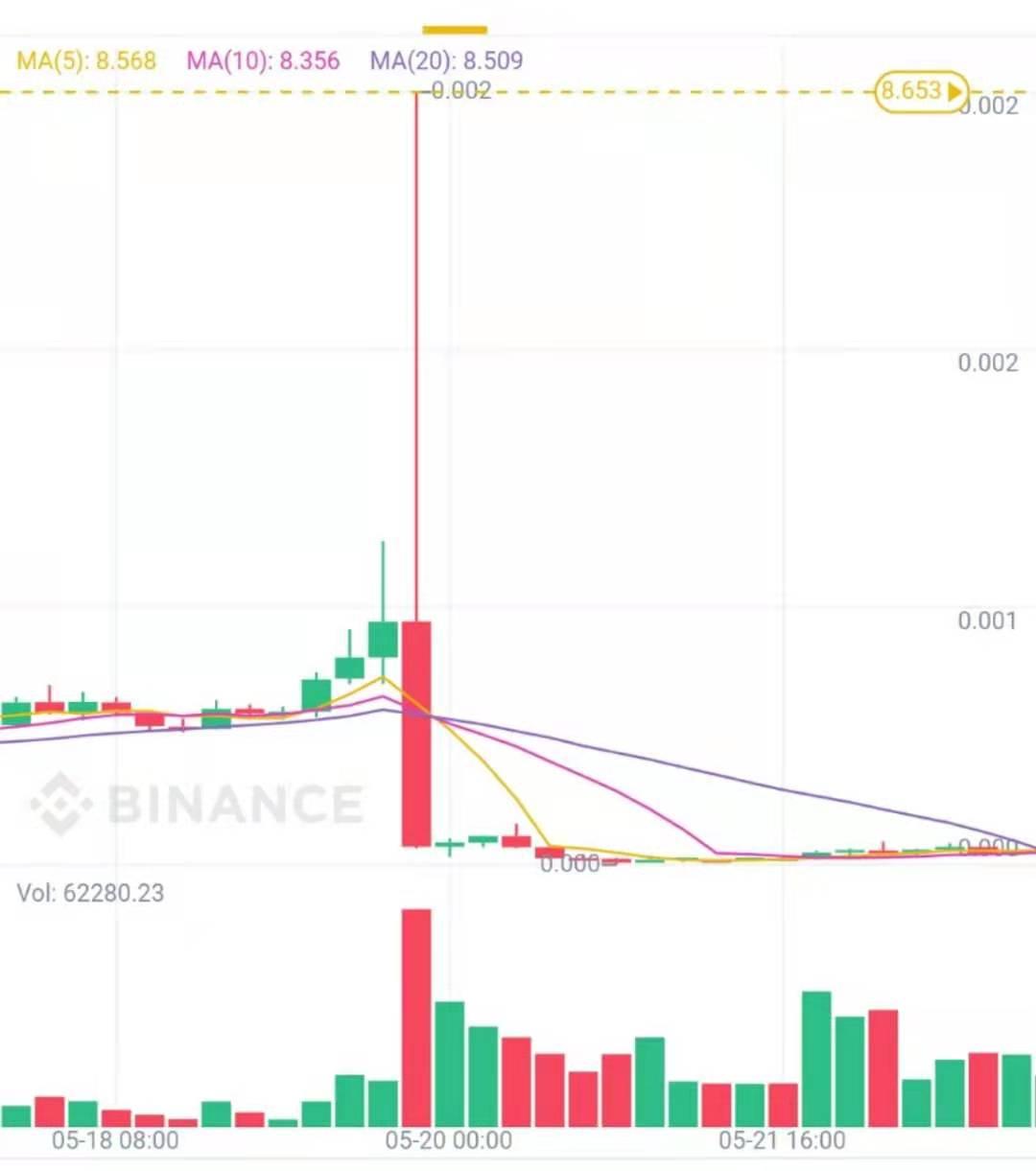Bloomberg Survey: Binance Leveraged Tokens Face User Doubts Due to 519 Crash
This article is from Bloomberg and translated by Chain Catcher.
On the day of one of the most severe crashes in the cryptocurrency market, Alex Holland woke up to a barrage of messages from friends and family. They knew he had recently made a big bet that prices would fall.
But when he checked his account on Binance, he found that the value of his short ETH leveraged tokens was declining, rather than yielding returns several times greater than the drop in the second-largest cryptocurrency.
"I kept blinking," said the 59-year-old Canadian, who is paralyzed after a skiing accident. "I thought it was just a glitch and they would fix it."
By the end of May 19, ETH had plummeted about 20%, while Holland's short tokens had crashed about 85%. The price fell so low that it showed as zero on the price chart.

Note: Price trend of Binance short ETH leveraged tokens, supplemented by Chain Catcher
Traders associated with cryptocurrencies love to make big leveraged bets until an inexplicable crash occurs.
In a way, this is an age-old cautionary tale akin to Wall Street—retail speculators hurt by Byzantine derivatives—amplified by a lack of regulation, shaky market channels, and the extreme volatility of the $1.3 trillion crypto world.
It's hard to know exactly how much value has been wiped out. But now, an increasing number of disgruntled Binance users are organizing to pressure the exchange for compensation for their losses through a combination of social media and legal threats. Regulators have also taken notice, and Binance is facing increasing scrutiny in Asia, North America, and Europe.
Holland's records show that from April to May 19, he invested about $2,700 in bearish tokens through a series of trades. Including his previous trades, he estimates his total investment at around $10,000.
Cryptocurrency exchanges promote leveraged tokens as an easy way for amateurs to make large bets without the hassle of managing collateral or margin requirements. On Binance, the product provides exposure to cryptocurrencies on the long or short side using futures, with a unique twist: the leverage fluctuates between 1.25x and 4x. This means that, theoretically, a 20% drop in the coin should translate to a 25% to 80% gain.
The world's largest cryptocurrency exchange touts this unpredictability as a feature, not a flaw. But it also prompts traders to question how they are managed, especially during periods of frenzied volatility, which is a characteristic of the market.
Holland's experience on May 19 was typical. Despite betting in the right direction, the short tokens bundled with LTC and XTZ still lost money. The short token for DOT ultimately valued less than 3 cents, plummeting 95% from the previous day. At one point, both the long and short ETH tokens dropped about 75%.
May 19 was overall a turbulent day, with crypto platforms including Binance and Coinbase experiencing disruptions in normal trading after negative tweets from Elon Musk and tightening restrictions in China led investors to flee.
Binance stated that as more traders sought to cash out their bearish leveraged tokens, capital outflows caused leverage to spike in some cases. When the plan was forced to cut its short exposure in a turbulent and illiquid market to lower the ratio again, it ultimately incurred losses due to market conditions.
In other words, the product was forced to continuously cut positions at the worst possible times. That day, the ETH short tokens were rebalanced 21 times, most of which were completed within half an hour.
A spokesperson said in an email, "However, we should note that during this period, there were no identifiable issues or errors with Binance leveraged tokens." Binance users were informed in advance of the risks associated with any trading activity, "including through training videos and testing their understanding."
During the worst of the sell-off, the platform suspended trading for most leveraged tokens. It no longer allows the purchase or exchange of tokens during rebalancing.
The product is somewhat similar to leveraged exchange-traded funds (ETFs), which typically rebalance at the end of each day to maintain a specific exposure. The difference is that Binance leveraged tokens only rebalance when the leverage exceeds the range of 1.25x to 4x, based on a proprietary algorithm that determines that ratio.
Tim Leung, a professor of applied mathematics at the University of Washington, warned that one issue with the lack of regular rebalancing is that the product naturally becomes more leveraged when the market moves against it.
"It's too opaque," he said of the structure of such retail products. "An investor looks at the historical leverage and thinks it should be 2x, but there's no guarantee that the future leverage will be 2x."
Even through regulatory means, retail investors are almost powerless. As an entity located in multiple jurisdictions, Binance's terms stipulate that any disputes must be arbitrated individually in Hong Kong, preventing class action claims.
For Holland, this is another blow to his long-held faith in cryptocurrency. After initially accumulating some tokens by operating a crypto mining platform, he lost all his funds in the Canadian exchange QuadrigaCX. QuadrigaCX was a Canadian exchange that wiped out at least $125 million in customer funds when it collapsed in 2019.
When it came to choosing another exchange, he thought he was right to choose the largest one in the crypto world.
"It's a lot of money for me, even though I predicted everything correctly," he said in Calgary, Canada. "Given my situation, this was my only retirement opportunity, and now it's almost gone."
Note: For more analysis on leveraged tokens, refer to Chain Catcher's previous investigative article "In-depth Analysis of the 'Harvesting Techniques' of Leveraged Tokens"










